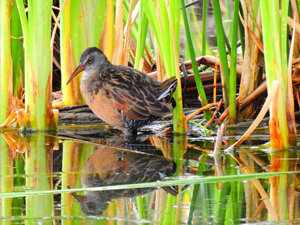
This week’s Bird of the Week, compliments of the Weminuche Audubon Society and Audubon Rockies, is the Virginia rail.
Like its relative the Sora, this is a secretive bird of densely vegetated shallow wetlands. Its preferred habitat has water levels less than 6 inches deep, a muddy bottom and open areas ringed by a thick cover of cattails, rushes, sedges and grasses.
Here, Virginia rails are seen in the warm-water wetland ponds along the Riverwalk. Those willing to quietly wait may be rewarded with a glimpse when the bird moves on the edges of the vegetation or pops out into the open to feed. Most often the only indication of their presence is the sound of their calls, described as clicks, grunts and oinks, coming from deep within the vegetation.
Long, strong legs and toes allow this rail to walk and run on floating mats of vegetation. It is also able to swim and dive, but outside of migration, flights are generally short and weak. It uses its long, reddish, slightly down-curved bill to probe in the mud for invertebrates like beetles, snails, spiders and flies. Small fish, some plant matter and seeds are also consumed.
When seen head-on, the Virginia rail looks very thin, while a side view makes it appear full-bodied. This laterally compressed body type and flexible vertebrae are adaptations which allow the bird to move through nearly impenetrable vegetation. Special ends on feathers of the forehead resist wear and tear.
The cinnamon-colored Virginia rail has black and white barring on the sides, a gray face and a short, stubby tail which confers a chicken-like look. New chicks are puff balls of downy black. A family remains together on the breeding territory until the chicks are full grown, at which time the adults may depart.
After breeding, Virginia rails head to parts of the southern United States or Mexico for the winter. In Colorado, fall migration for these birds peaks between mid-August and mid-September, but in many years they remain in our warm water wetlands until early December.
For information on events, visit www.weminucheaudubon.org and www.facebook.com/weminucheaudubon/.